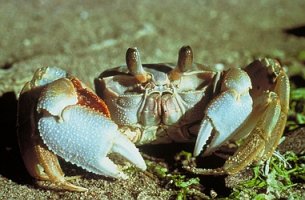 I have read that there are almost 5,000 different species of crabs, about 4,500 of them are true crabs, plus about 500 or so are hermit crabs. I must confess that I personally have seen less than 30 different kinds. From the smallest hermit crabs to huge spider crabs in the South Island and in Southern Tasmania (Australia).
I have read that there are almost 5,000 different species of crabs, about 4,500 of them are true crabs, plus about 500 or so are hermit crabs. I must confess that I personally have seen less than 30 different kinds. From the smallest hermit crabs to huge spider crabs in the South Island and in Southern Tasmania (Australia).
Most crabs live in the oceans, They have ten jointed legs, two of which have large, grasping claws (called pincers).
They have a flattened body, two feelers (antennae), and two eyes located at the ends of stalks. These animals also walk sideways.
The hermit crabs don't have a very hard shell, and use other animals old shells for protection.
A few of the more common crabs I think would be the hermit crab, the large shore crab otherwise known as the purple crab, and the red crabs. The red crab is often found in rock pools and rocky crevises around shorelines. And I think the most common would be the large shore crab.
The paddle crab. is found off sandy beaches, and in harbours and estuaries throughout the whole of New Zealand, including the Chatham Islands, and east and south Australia.
These spicies are abundant from the intertidal zone to at least 10 m 30 feet depth, although they may be found in much deeper water.
The biggest crab found is the Japanese Spider crab which lives on the floor of the North Pacific Ocean, it has a 3.7 mts (12 ft) leg span (that's big).
The crabs are mainly active in early evening or at night, when they move into the shallower intertidal zone to feed. The paddle crabs are versatile and opportunistic predators.
Many crabs are omnivores (plant and meat eaters), others are carnivores (meat eaters), and some are herbivores (plant eaters). They feed mainly on either molluscs or crustaceans, but also on polychaetes, several fish species, cumaceans, and occasionally on algae. Cannibalism is common, particularly on small crabs and during the winter moulting season.
Crabs are invertebrates, this means that they do not have a backbone. Insted they have an exoskeleton (carapace), an outer shell that both protects them from predators and provides support.
Crabs breath underwater using gills, which are located in a two cavities under the carapace.
Mating generally occurs during winter and spring in the sheltered inshore waters. Female crabs can only mate when they are soft-shelled.